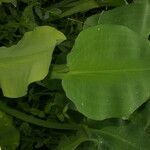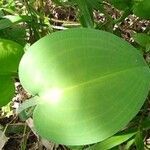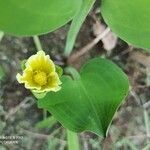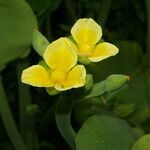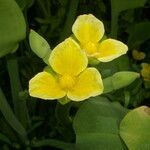Petiole trigonous, 20-65 cm, stout; leaf blade 6-28 × 4.5-20 cm, veins 9-13, transverse veins numerous, parallel, base obtuse or subcordate, apex obtuse or retuse. Scapes upper trigonous, 20-90 cm; umbels 2-15-flowered; bracts green, orbic-ular to broadly elliptic, 1.5-2 × 1-1.5 cm. Pedicels 2-7 cm. Petals yellowish but blackish toward base, broadly ovate to orbicular, 2-3 × 1-2 cm, apex rounded. Stamens shorter than petals; filaments green. Carpels yellowish green. Fruit cluster 1.5-2 cm in diam.; follicles suborbicular. Seeds brown. Fl. Mar-Apr.
Leaves basal, narrowly lanceolate to ovate, attenuate or cordate at the base, 1-2 dm. long, somewhat shorter than the peti-oles. Flowering scapes somewhat shorter than the petioles; umbels bearing 3-15 mediocre yellow flowers; pedicels stout, 2-4 cm. long; sepals greenish or yellowish, about 1 cm. long, accrescent and enveloping the fruiting head; petals somewhat surpassing the sepals.
A herb which grows in water. The leaves form tufts. They are oval and 15-18 cm long by 12 cm wide. The leaf stalk is angular and 30 cm long. The flower head in at the end of the shoot and has a long flower stalk. There is a sheath like a membrane near the base. There are 5-10 flowers together. They are yellow.
